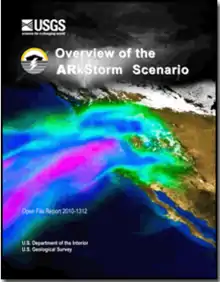ARkStorm
An ARkStorm (for atmospheric river 1,000 storm) is a hypothetical but scientifically realistic "megastorm" scenario developed and published by the Multi Hazards Demonstration Project (MHDP) of the United States Geological Survey, based on historical occurrences. It describes an extreme storm that could devastate much of California, causing up to $725 billion in losses (mostly due to flooding), and affect a quarter of California's homes. The event would be similar to exceptionally intense California storms that occurred between December 1861 and January 1862, which dumped nearly 10 feet of rain in parts of California, over a period of 43 days.[1][2] The name "ARkStorm" means "atmospheric river (AR) 1,000 (k)" as the storm was originally projected as a 1-in-1000-year event.[3]

The USGS sediment research in the San Francisco Bay Area, Santa Barbara basin, Sacramento Valley, and Klamath Mountain region have indicated that "megastorms" similar to the ARkStorm scenario have occurred in the following years A.D.: 212, 440, 603, 1029, c. 1300, 1418, 1605, 1750, 1810, and December 1861–January 1862 (the latest occurrence). Based on the intervals of known occurrences, ranging from 51 to 426 years, scientists have concluded that these events have a mean return period of around 150–200 years.[1] Geologic evidence also indicates that several of the previous events were more intense than the one in 1861–62, particularly the events in 440, 1418, 1605, and 1750, each of which deposited a layer of silt in the Santa Barbara Basin more than one inch thick. The largest event was the one in 1605, which left behind a layer of silt two inches thick, indicating that this flood was at least 50% more powerful than any of the others recorded. The floods more intense than the 1861–62 event appear to occur at intervals of 200 years or so.[1]
Description

If the ARkStorm scenario were to occur, it would have the following effects:
- The Central Valley would experience flooding 300 miles (480 km) long and at least 20 miles (30 km) wide.
- Serious flooding also would occur in Orange County, Los Angeles County, San Diego, the San Francisco Bay area, and other coastal communities.
- Wind speeds in some places would reach 125 miles per hour (200 km/h).
- Hundreds of landslides would damage roads, highways, and homes.
- Property damage would exceed $300 billion, most from flooding.
- Demand surge (an increase in labor rates and other repair costs after major natural disasters) could increase property losses by 20 percent.
- Agricultural losses and other costs to repair lifelines, drain flooded islands, and repair damage from landslides, could bring the total direct property loss to nearly $400 billion.
- Power, water, sewer, and other lifelines would experience damage that could take weeks or months to restore.[4]
- Up to 1.5 million residents in the inland region and delta counties would need to evacuate due to flooding.
- Business interruption costs could reach $325 billion, in addition to the $400 billion required for property repair costs, meaning that an ARkStorm could cost a total of $725 billion, nearly three times the amount of damage predicted by the "California ShakeOut", a hypothetical Southern California earthquake with roughly the same annual occurrence probability.[3]
See also
References
- Dettinger, M. D.; Ingram, B. L. (January 2013). "The Coming Megafloods" (PDF). American Scientific. 169: 64–71.
- Null, J.; Hulbert, J. (2007). "California Washed Away: The Great Flood of 1862". Weatherwise. 60 (1): 26–30. doi:10.3200/wewi.60.1.26-30.
- Porter, Keith; et al. (2011). "Overview of the ARkStorm scenario". USGS Open-File 2010-1312.
- Philpott, Tom (August 29, 2020). "The Biblical Flood That Will Drown California". Wired. ISSN 1059-1028. Retrieved 2020-08-29.
External links
- USGS Multi-Hazards Demonstration Project: ARkStorm: West Coast Storm Scenario (including video)
- USGS Newsroom: ARkStorm: California’s other "Big One"
- Weather Underground - The ARkStorm: California's coming great deluge
- High Country News: The other Big One, Judith Lewis
- Water Education Foundation, Mar-Apr 2011: Plausible and Inevitable: The ARkStorm Scenario, by Gary Pitzer
- Megastorms Could Drown Massive Portions of California January 5, 2012 Scientific American
- Eric Zerkel (December 21, 2017). "California: The Flood That Could Change Everything". The Weather Company. Retrieved December 24, 2017.
- Ingram, B. Lynn (January 1, 2013). "California Megaflood: Lessons from a Forgotten Catastrophe". Scientific American. Retrieved 22 February 2019.